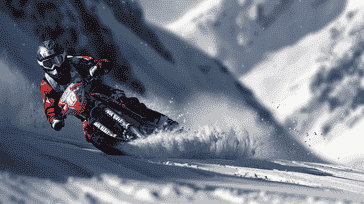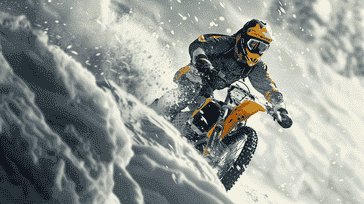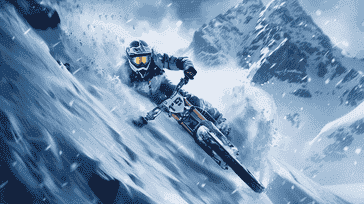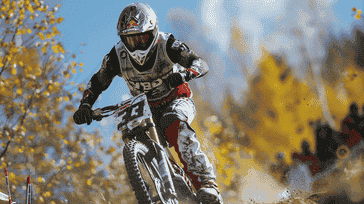
Are you ready to embrace the thrill of extreme sports and the rush of adrenaline? Look no further than downhill racing, a heart-pounding discipline that takes mountain biking to the next level. Whether you're a seasoned athlete or a curious adventurer, downhill racing offers an exhilarating experience that combines speed, skill, and strategy.
In this article, we delve into the world of downhill racing, exploring the basics, embracing the challenges, and uncovering the strategies that can help you conquer the course with confidence. From the essential gear to the training techniques used by professionals, we've got everything you need to take your downhill racing skills to new heights. So, grab your mountain bike, tighten your helmet, and get ready to ride on the edge of excitement!
Downhill racing is a thrilling and adrenaline-fueled sport that falls under the category of extreme sports. It involves racing downhill on a mountain bike at high speeds, navigating challenging terrains and obstacles along the way. This high-speed competitive activity attracts thrill-seekers and outdoor enthusiasts alike.
At its core, downhill racing combines the skill and precision of mountain biking with the adrenaline rush of extreme sports. Riders need to possess exceptional bike-handling skills, as they face steep descents, tight corners, and rough trails throughout the race. It requires not only physical strength and endurance but also mental acuity and quick reflexes.
Competitors in downhill racing follow a designated course that may include jumps, drops, and technical features. Each race has a specific distance and elevation descent, adding to the intensity and excitement of the event. The aim is to complete the course in the fastest time possible, surpassing competitors and pushing the limits of speed and technique.
One of the biggest challenges that downhill racers face is maintaining control and balance at high speeds. The terrain conditions can vary greatly, from loose gravel to mud and roots, posing additional obstacles to overcome. The ability to adapt and react quickly to these changing conditions is crucial in maximizing performance and minimizing risks.
Downhill racing is not without its risks. The sport inherently carries the potential for crashes and injuries. Riders must wear proper protective gear, including helmets, body armor, and knee pads, to mitigate the risks associated with high-speed descents and technical maneuvers.
As an extreme sport, downhill racing requires a commitment to training and preparation. Riders engage in rigorous physical conditioning, focusing on strength, flexibility, and endurance. Mental preparation is also essential, as racers need to maintain focus and concentration during the intense and fast-paced nature of the competition.
In conclusion, downhill racing is a challenging and exhilarating sport that combines the thrill of extreme sports with the technicality of mountain biking. It requires skill, courage, and a love for speed, making it a favorite among adrenaline enthusiasts seeking outdoor adventure.

When it comes to extreme sports like mountain biking, having the right gear is crucial for both safety and performance. Downhill racing, in particular, requires specialized equipment that can withstand the intense speeds and rough terrains.
One of the most important pieces of gear for downhill racing is the bike itself. These bikes are specifically designed to handle the challenging conditions encountered during races. They feature robust suspension systems that absorb impact and provide stability, allowing riders to maintain control at high speeds.
Another essential item for downhill racing is a high-quality helmet. Protecting your head is of utmost importance, as crashes and falls can happen at any moment. Look for helmets that meet safety standards and provide adequate protection for your head and face.
In addition to a helmet, protective gear is crucial for downhill racing. Riders often wear body armor, including chest protectors, knee pads, and elbow pads, to safeguard themselves from injuries. These protective measures reduce the impact of falls and collisions, ensuring that riders can continue racing without compromising their safety.
Specialized clothing is also a significant part of the downhill racing gear. Lightweight, breathable jerseys and shorts designed for mountain biking provide comfort and freedom of movement. Gloves with reinforced padding offer better grip and protect your hands from the vibrations and impacts of the ride.
For additional safety, riders should also have a reliable hydration system to stay hydrated during long races. Water bottles or hydration packs can be attached to the bike or worn on the rider's back, ensuring that they have access to fluids throughout the race.
Finally, it's essential to have the appropriate footwear for downhill racing. Mountain bike shoes with stiff soles and efficient pedal grip enhance power transfer and control. The right shoes will give riders the confidence to tackle challenging terrain and make quick adjustments when necessary.
Investing in high-quality gear is not only essential for safety but can also significantly impact your performance. Having reliable equipment allows you to focus on the race and push your limits without worrying about equipment failure.
"Downhill racing demands a unique set of equipment to tackle the extreme challenges of the sport. From specialized bikes to protective gear, each piece plays a vital role in keeping riders safe and ensuring optimum performance."
Training is a crucial aspect of becoming a successful downhill racer. The combination of physical conditioning and mental preparation is essential for handling the intense outdoor adventure, adrenaline rush, and extreme sports competition that downhill racing offers. Here, we delve into the key training techniques used by professional athletes in this exhilarating sport.
Downhill racing demands superior physical fitness to navigate treacherous terrains and endure the challenges of the sport. Athletes focus on building strength, agility, and endurance to enhance their performance on the mountain. Training programs often include:
Aside from physical conditioning, downhill racers understand the importance of mental preparation to navigate the adrenaline-pumping extreme sports competition. Mental fortitude plays a significant role in overcoming challenges and maintaining focus during high-speed descents. Key strategies for mental preparation include:
"Mental strength is just as important as physical strength in downhill racing. Building a strong mind helps me stay focused and make split-second decisions on the course."
- Pro Downhill Racer, Emily Jones
Downhill racing requires mastering specific technical skills to tackle various terrains and obstacles. Developing these skills through consistent training and practice is vital for a successful race. Key technical skills include:
By focusing on physical conditioning, mental preparation, and technical skills, aspiring downhill racers can enhance their outdoor adventure, adrenaline rush, and extreme sports competition capabilities. Training like a pro sets the foundation for success on the mountain.
| Training Techniques | Benefits |
|---|---|
| High-intensity interval training (HIIT) | Improves cardiovascular fitness |
| Weightlifting exercises | Increases lower body strength and power |
| Core strengthening exercises | Enhances stability and balance |
| Visualization techniques | Aids in mentally rehearsing race lines |
| Meditation and mindfulness practices | Improves concentration and stress management |
| Positive mindset development | Enhances confidence and resilience |

When it comes to extreme sports competition, mountain biking has its own unique challenges and thrills. One of the key aspects to master in downhill racing is conquering the course, navigating through various terrains with precision and speed. In this section, we will explore race strategies and techniques that can help riders optimize their performance and achieve success on the mountain.
Line Selection: One of the critical factors in downhill racing is choosing the right line on the course. The line selection determines the path a rider takes and can significantly impact their speed and control. Experienced riders analyze the terrain, evaluate the best routes, and adjust their approach accordingly. They consider factors such as terrain features, obstacles, and corners to identify the fastest and smoothest line.
Cornering Skills: Effective cornering is essential for maintaining speed and control on downhill courses. Expert riders use a combination of body positioning, braking techniques, and line selection to navigate tight turns and hairpin bends. They lean into the corners, apply necessary braking forces, and accelerate out smoothly to maintain momentum. Developing good cornering skills is key to maximizing speed and minimizing the time lost in each turn.
"Mastering the art of downhill racing requires riders to strike a delicate balance between speed and control. It's about finding the optimal line and making split-second decisions to tackle each obstacle and turn."
Technical Sections: Downhill courses often contain technical sections that demand advanced riding skills. These sections may include rock gardens, drops, jumps, or steep descents. Riders must possess the necessary bike handling skills and confidence to tackle these challenging features successfully. Knowing when to pump, shift weight, or maintain a stable body position can make all the difference in conquering technical sections with finesse.
Visualization and Pre-riding: Mental preparation plays a crucial role in downhill racing. Professional riders not only physically train their bodies but also visualize their race runs and pre-ride the course when possible. Mental imagery allows them to familiarize themselves with the course, plan their lines, and build confidence in their abilities. By mentally rehearsing their race runs, riders can anticipate challenges and execute their strategies more effectively.
Throughout the history of downhill racing, different riders have employed unique strategies that have proven successful. Let's take a look at a few notable strategies used by renowned downhill racers:
These strategies, along with effective line selection, cornering skills, and mental preparation, help riders conquer challenging courses and achieve remarkable success in extreme sports competitions.
| Technique | Description |
|---|---|
| Line Selection | Choosing the optimal path on the course to maximize speed and control. |
| Cornering Skills | Navigating turns with precision and speed, maintaining momentum. |
| Technical Sections | Successfully tackling challenging features like rock gardens, drops, and jumps. |
| Visualization and Pre-riding | Familiarizing oneself with the course mentally and physically prior to the race. |
Competitive spirit is at the core of extreme sports. Downhill racing, in particular, demands a mindset of relentless determination and a thirst for victory. Thriving in the world of extreme sports requires athletes to push their limits and surpass their own expectations.
As enthusiasts of downhill racing, we understand the unique challenges and risks involved in this adrenaline-fueled sport. It's not just about the physical prowess, but also about mental fortitude and the ability to adapt to ever-changing terrains and conditions.
The athletes who excel in extreme sports like downhill racing are those who embrace the concept of calculated risk-taking. They understand that pushing the limits is not reckless, but a calculated decision based on their skills, experience, and knowledge of the course.
"In downhill racing, you have to be fearless yet focused. It's about finding the balance between seizing opportunities and calculated decision-making," says Mark Roberts, a renowned downhill racer who has conquered some of the most challenging mountain trails.
"To thrive in extreme sports competition, you need to develop a deep understanding of your own abilities and constantly challenge yourself to go beyond what is comfortable. It's a constant battle between mind and mountain, but the rewards are indescribable," adds Roberts.
Extreme sports athletes, including downhill racers, train rigorously to build physical strength, endurance, and mental resilience. They push themselves to their limits during training sessions, tackling demanding trails and obstacles.
One of the key aspects of thriving in extreme sports competition is mastering fear. Downhill racers confront gravity-defying drops, treacherous jumps, and hairpin turns that can be intimidating even to the most seasoned professionals.
Overcoming fear is a continuous journey for extreme athletes. They learn to control their emotions, channeling their excitement and nervousness into focused energy.
Downhill racing is not for the faint-hearted. The unpredictable nature of the sport challenges athletes to adapt quickly to unexpected situations.
Whether it's a sudden change in weather, an unforeseen obstacle on the trail, or a split-second decision during a race, downhill racers must think on their feet and make split-second decisions that can make or break their performance.
Thriving in extreme sports competition requires a mindset that acknowledges the significance of both the process and the outcome. It's not just about winning medals; it's about the journey, the growth, and the personal milestones achieved along the way.
Downhill racing is a testament to the human spirit, pushing the limits of what is possible and embracing the challenges that come with it. It's about finding fulfillment in the pursuit of excellence and conquering the uncharted territories of the mountain.
In the next section, we will delve into the strategies and techniques that can help aspiring downhill racers conquer the course and elevate their performance to new heights.

Downhill racing is the epitome of extreme sports and outdoor adventure. It offers an adrenaline rush like no other, captivating thrill-seekers from around the world. Throughout this article, we've explored the exhilarating world of downhill racing, delving into the basics, equipment, training, strategies, and competitive mindset required for success.
From the moment you push off and feel the wind in your face, the rush of speed takes over, fueling your passion for extreme sports. The heart-pounding descents, challenging terrains, and intense competition all contribute to the addictive nature of downhill racing. It's a sport that pushes your limits and rewards determination, courage, and skill.
As you conquer each course, the sense of accomplishment is unmatched. But beyond the personal victories, downhill racing is part of a larger community of adrenaline junkies who thrive on outdoor adventures. It's about embracing the wild, savoring the freedom, and seeking new challenges.
So, if you're ready to embark on an extraordinary journey filled with incredible highs and the thrill of extreme sports, gear up, train hard, and dive headfirst into the world of downhill racing. Let the adrenaline rush take hold and experience the ultimate outdoor adventure.
Downhill racing is an extreme sport that involves racing bicycles down a steep and challenging terrain. It is a high-speed and adrenaline-pumping adventure where athletes strive to navigate the course in the fastest time possible.
Downhill racing is considered an extreme sport due to its daring nature and the physical and mental challenges it presents. The fast speeds, steep slopes, and technical obstacles make it an adrenaline-filled and high-risk activity.
To participate in downhill racing, athletes need specialized mountain bikes with strong suspension systems, protective gear including helmets, goggles, body armor, and appropriate clothing. It is crucial to have equipment that provides both safety and optimal performance.
Training for downhill racing requires a combination of physical conditioning and mental preparation. This may include strength and endurance training, practicing bike handling skills on different terrains, and visualizing race scenarios to develop concentration and confidence.
Successful downhill racing requires effective race strategies such as choosing the best lines on the course, maintaining proper body position, mastering cornering techniques, and adjusting speed and braking techniques to maintain control while maximizing speed.
Downhill racing is an extreme sport that requires advanced skills and experience. It is not recommended for beginners unless they have received proper training and have a solid foundation in mountain biking. Beginner riders should first focus on building their skills and gradually progress to downhill racing.
Downhill racing carries inherent risks, including the possibility of crashes, injuries, and accidents. Riders should be aware of the dangers involved and take appropriate safety measures. Wearing protective gear, practicing good bike control, and knowing one's limits are essential in managing these risks.